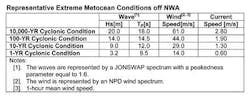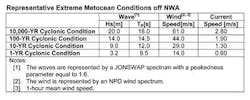Jinzhu Xia
Granherne Pty Ltd.,
a KBR company
Since theJabiru Venture became the first FPSO offshore Australia in 1986, the requirements for FPSOs have changed. The greatest changes are the cost and complexity of the topsides necessary for greater throughput and inclusion of gas compression. Capex of FPSOs has further increased due to double hull requirements and other safety and environmental standards. At the same time, the value of oil has increased. This means the cost to the operator for downtime and the profitability of uptime both are higher.
As the design requirements change, the design philosophy and methodology need to change. For deepwater FPSOs, the typical cost of a newbuild hull is 10-15% of the capex for the field facilities. The mooring and riser system costs can be an even higher percentage. Therefore, opting for a low-cost hull conversion may increase the cost of the mooring/riser systems and also result in high environmental downtime.
The design philosophy and methods that call for meeting specific metocean conditions from initial hull sizing are effective in minimizing environmental downtime of FPSOs, and in reducing both capex and opex of risers and moorings. A major emphasis in the design or selection of an FPSO hull should be given to its motion performance in site-specific metocean conditions to minimize production downtime. The financial benefits during a field life of increased productivity and deliverability and reduced structural maintenance can be significant.
Northwest Australia metocean conditions
The metocean environment offshore northwest Australia challenges floating platform design and operation. The gas-rich waters are in the most cyclone-prone area, having the highest incidence of cyclones in the Southern Hemisphere. On average, five tropical cyclones occur during each tropical cyclone season over the warm ocean waters off the northwest coast between 105°E and 125°E latitudes.
The west Australian cyclone season officially runs from November to April. At the start of the season, the most likely area to be affected is off the Kimberley and Pilbara coastline. The chance of experiencing a Category 4 or 5 cyclone is highest in March and April.
Local wind generated sea waves have typical peak periods between two and seven seconds and wave heights ranging between 0 to 4 m (13 ft) under non-tropical cyclone forces. The swell conditions result predominantly from storms in the Southern Ocean or southern portion of the Indian Ocean. It is a perennial feature of exposed northwest shelf waters. Typically, this swell arrives at the outer edge of the continental shelf from the south and southwest, before refracting during propagation across the shelf, to become more westerly and even northwesterly near-shore. Swell peak periods are typically in the 12 to 18 seconds range, but swell periods of 23 seconds have been measured.
In addition to Southern Ocean swells, the synoptic winter easterly winds which prevail may generate a short period easterly or north-easterly swell of six to 10 seconds. The effects of this short period easterly swell may not be visible in the measured swell data statistics, because this shorter period easterly swell will normally be incorporated within the sea data statistics during data processing. This swell condition does affect operability in the area.
Design philosophy
The site-specific metocean conditions have a great influence on operability and availability of a turret-moored FPSO. Designers must use site-specific metocean data in the design of the FPSO topsides and hull structures as well as in the design and selection of the process systems and equipment. The topsides, utilities, and offloading system each will have an availability based on the calculated operational windows according to the joint probability distributions of the site-specific wind, wave, and current conditions. The overall facility availability is the combined availability of all systems, equipment, and personnel onboard.
Regardless of the severity of specific metocean conditions, the hull and topsides systems and equipment should be designed to project-specific FPSO motion criteria in an iterative way. A high availability target tends to make such motion criteria more onerous for the design of systems and equipment, or will impose greater challenges for the hull designer to provide a low motion hull configuration. However, the process systems and equipment may be modified to perform under greater hull motions. A multi-disciplinary approach is required to achieve a realistic balance between expected hull motion and topsides availability.
Operational and extreme metocean conditions impact FPSO operability and availability in different ways. The main design objectives for the operational metocean conditions are twofold. The first is to minimize the probability of extreme vessel motion to provide greater windows of process plant operation, offloading operation, crew habitability, and helicopter operation. The second is to minimize the cumulative motion probability distributions for minimal structural, riser, and mooring fatigue.
Processing requires small roll and pitch motions, even with special internal baffling arrangements. Typically the separators cannot function effectively when roll or pitch amplitudes exceed 6° to the horizontal. Excessive angular motions reduce the quality of the separated products. However, in the absence of project-specific criteria at the design stage it is wise to target a lower limit of ±5° or less to account for the effects of horizontal acceleration and dynamic effects within the separators. For LGP and LNG FPSOs (FLNG) with fractionating columns installed, the maximum allowable roll amplitude is typically ±2º.
Small vessel motions are required for offloading of hydrocarbon liquids to shuttle tankers, and for crew comfort and safety. Roll motions are responsible for fatigue-induced loads in structures such as topsides modules and support structures, long flare towers, crane booms/pedestals, and piping supports. Minimum roll motion is also important from a structural stand point.
The impact of motions on risers:
- Low roll/pitch motions reduce stress levels and, hence, fatigue at the riser hanging points and flex or stress joints
- Small vertical motions at the riser hanging points minimize damage to the upper terminations of risers
- Fatigue damage at riser touch-down points is sensitive to high-frequency vertical motions of the riser hanging points.
The mooring system designed has to be coupled with the riser system design, taking into account the water depth and the type of riser system proposed. In deepwater, the riser system may drive the mooring design. Smaller allowable horizontal offsets for certain riser types will require high mooring line pretensions which can cause high fatigue damage to the mooring lines.
During the design process, predicted motion statistics of the FPSO should be derived based on operational wave occurrence probability distributions. The motion statistics should be compared with the motion criteria to determine operability and availability and the cumulative fatigue damage to the structures, risers, and mooring system.
In preliminary design, the motion criteria are often assessed using the motion response amplitude operators of the proposed vessel to determine the extreme motion characteristics under one-year return storm conditions at site. Such simplified approach underestimates the impact of swell effects for NWA sites, as the one-year return cyclonic conditions bear no correlation to the operational swell conditions. The persistent swell conditions off NWA have an unfavorable wave period range intersecting the natural rolling periods of many existing FPSOs. When not considered during design, they may induce much greater vessel motions than the one-year return extreme storm conditions, and result in shutdowns and structural integrity problems.
The tropical cyclonic metocean conditions offshore Western Australia and Northern Territory significantly impact the design and operation of offshore production facilities. Although cyclones may be regarded as extreme conditions, they are regular and unavoidable occurrences, and as such require distinct design considerations to ensure safety and integrity of the platform.
The greatest impact of extreme cyclonic conditions on operability and availability is the station-keeping strategy; whether the FPSO is designed and installed as a permanently moored facility, or as a disconnectable facility that sails away during cyclones.
The harsh environmental conditions off NWA require a turret mooring system. In the North West Shelf and Timor Sea regions of Australia both permanently moored and disconnectable FPSOs have been installed. The disconnectable option is the more popular for existing FPSOs in northwest Australian waters where the extreme cyclonic conditions are harsher than for the Timor Sea.
Disconnectable turrets are more complex because of mechanical requirements for the disconnect system, increased maintenance requirements, and full marine crew, propulsion plant, double hull, and other hull requirements. For the first-generation disconnectable turrets, reconnect times exceeded predictions and sometimes required diver intervention to reconnect lost tag lines. Disconnection and reconnection may lead to many more days of production loss than permanently moored FPSOs in the cyclone-prone areas.
Recent studies for FLNG applications confirm that downsides associated with availability, safety and integrity, along with heightened industrial risk, makes the disconnectable option less attractive. It is feasible to apply permanent mooring systems for FPSO type facilities in NWA fields. The permanent option is better because:
- Overall availability may be improved by 5-10% against the disconnectable option
- Hazards associated with releasing and reconnecting to the mooring and risers are eliminated
- No maritime navigation personnel are required onboard.
An FPSO may be designed to remain manned and operational or partially operational during cyclones to minimize risk to personnel and weather related downtime caused by disconnection or demanning. The relevant design and operational measures may include:
- The structures (including riser and mooring systems) and accommodations designed to survive up to 10,000-year return weather events
- The facilities are designed to remain operational or partially operational in cyclonic weather with operating envelopes identified against sea states and hull motions
- Habitability of the temporary refuge areas on the floating facility during cyclones is acceptable
- A practical weather envelope within which the process is deemed safe to operate is determined and embodied in the operational procedures
- The option remains for a management decision to manually shut in and/or to deman.
In harsh locations with divergent wave, wind and current regimes, an effective dynamic heading control system may be a benefit as this could reduce roll motions and thereby increase the overall system availability and crew comfort and safety. Other advantages of the heading control system are that with the turret positioned further aft, the motions at the risers will be reduced and accommodation can be placed upwind of the hazardous process systems.
Turret costs vary significantly depending on complexity of the application, numbers of risers and fluid paths through the swivel, water depth, vessel size, etc. In such cases, the cost for a turret and swivel system can be comparable to the cost of the FPSO hull itself. In deepwater applications, the high reservoir pressures and temperatures may create feasibility issues for fluid swivel seals in the turrets.
Design methods
The first step in the design is to identify the natural periods of roll and heave. Roll natural period is generally one or two seconds below heave natural period for ship-shape FPSO and is less critical due to high damping. The required natural periods of roll and heave are determined from the field environmental data.
The natural roll period should be two to three seconds higher than peak period of the most unfavorable wave environment for turret-moored system and three to five seconds for spread-moored system. To avoid rolling resonance with the persistent Southern Ocean swells with wave peak periods between 12 and 18 seconds, the natural rolling period of the FPSO should be more than 20 seconds. This also ensures that excessive roll motions in extreme cyclonic conditions can be avoided for a location with a wave peak period of 18 seconds for 10,000-year return cyclones.
A heave natural period of about 11 seconds will be favorable to avoid heave resonance with both operational wind seas of two to seven seconds and persistent Southern Ocean swells of 12 to 18 seconds.
Sizing with targeted natural periods
For specified storage capacity and topsides weight, the principal dimensions of the hull determine the natural periods of the vessel. Other factors that influence the natural periods include ballast capacity and distribution.
A hull form with a high beam/depth (B/D) ratio would have a low vertical center of gravity from keel (KG), and high hydrostatic restoring stiffness resulting in a high metacentric height, causing the roll natural period to be low. In other words, the roll natural period increases as the B/D ratio decreases. The heave and pitch natural periods vary predominantly with the variation of the draft/length (T/L) ratio of the vessel.
The determination of the principal dimensions of the hull is an iterative process capable of sizing a mono-hull FPSO or FPU for the required storage capacity, topsides weight, deck space, and the required natural periods.
The lightship hull weight can be estimated based on the cubic volume of the hull type. For FPSOs equipped with thrusters, adequate ballast tank capacity is required to achieve sufficient draught to ensure that the thrusters are always fully submerged during severe weather conditions. For FPSOs without thrusters, experience shows that sufficient ballast to achieve IMO minimum ballast draught for tankers provides a reasonable ballast draught for motion response, trim control, and control of hull bending and shear stresses.
During the design iteration process, the beam, L/B ratio, and ballast capacity of the hull are varied until the required natural periods of roll and heave are achieved. In general, lower B/D ratios are required for the NWA, west of Shetland, and offshore Angola to achieve the high roll natural period of more than 20 seconds. A lower B/D ratio also increases the mid-ship section modulus of the vessel, which is beneficial for longitudinal structural strength. Further hull bending moment reductions can be achieved by optimization of the bow and stern section forms, which is also crucial for slamming and green water performances.
For internal turret FPSO design, the hull longitudinal bending moments are minimized by limiting the L/B ratio to about 5.5. For external turret FPSO and spread-moored FPSO designs, the L/B ratio can be less than 5.0. The high L/B ratio results in an increase in hull cost because hull section properties also have to be increased to cope with the increased longitudinal bending moment, which is proportional to the square of the hull length.
Design for rolling damping
Oil tankers have large bilge radii to reduce drag and maximize transit speed. Typically, VLCCs have bilge radii of about 2.50 m (8.2 ft). In FPSO design, a smaller bilge radius increases the roll damping and hence decreases the roll motions. However, a very small bilge radius can lead to stress concentration and hull fatigue from longitudinal bending. A bilge radius of l.00 m to 1.50 m (3.3 ft to 4.9 ft) for FPSOs is considered the optimum range to strike a balance between roll damping and hull fatigue. The reduced bilge radius also helps to reduce construction costs.
It is often difficult at the early stages of design to know what the final topsides weight will be, and therefore, a robust design should consider additional roll damping mechanisms such as bilge keels. Conditions encountered during transit to field may exceed the design conditions for the field, further requiring consideration to be given to the addition of bilge keels. The introduction of bilge keels should be considered as a secondary measure in the design to address excessive roll motion. The function of bilge keel is to increase the roll damping, but it does not significantly affect the roll natural period. Attention also should be given to detail design, material, welding of bilge keels, and hull interface construction.
Design verification
When verifying the motions of an FPSO in operational sea states, most of the hydrodynamic forces acting on the hull can be calculated using 3D linear potential flow theory or diffraction theory. Heave and pitch motions can be predicted accurately because viscous effects in these motion modes are negligible.
The prediction of roll due to wave excitation is a classical challenge in the field of naval architecture. For most FPSO hull forms, the roll damping predicted by the potential flow theory is relatively small. The system damping usually is dominated by viscous effects. It is common for the calculation of roll damping to use measured values to account for viscous effects.
Deepwater moorings and risers introduce sources of damping that are not included in the classical roll damping problem. This adds to the justification for advanced FPSO design verification involving numerical modeling of coupled vessel, mooring, and riser systems.
Verifying vessel motions and structural performance in storm conditions requires more advanced modeling. Non-linear time-domain methods generally are used to predict the vessel motion histories, slamming and green water performance, and non-linear sagging and hogging bending moments. Model testing of coupled FPSO systems is an important part of design verification and validation for deepwater projects as far as the hull, mooring, and riser performance are concerned.
Acknowledgment
The author gratefully acknowledges the support and input provided by Granherne and KBR colleagues during the preparation of this publication. Based on a paper presented at Deep Offshore Technology International Conference & Exhibition, held Nov. 27-29, 2012, in Perth, Australia.





